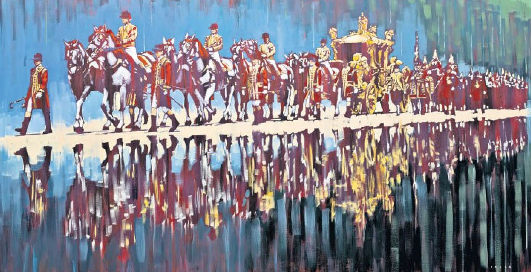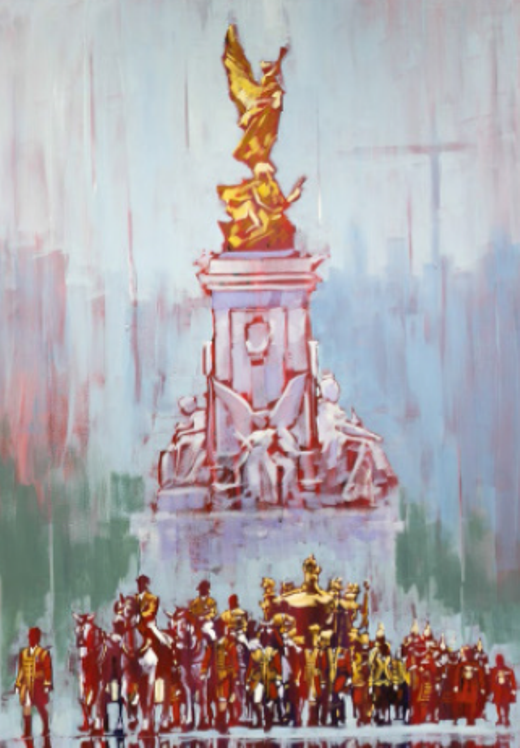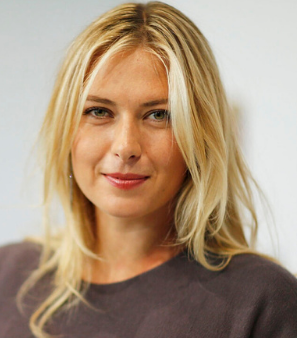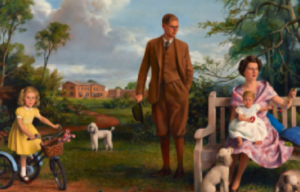WHEN it came to the life of the late Queen, two things mattered more than most: service and horses. Therefore, any attempt to capture her momentous final year would require someone with the skills and knowledge to illustrate both. Step forward Freddy Paske, Royal Artist in Residence for the past year—one that began in celebration and ended in grief.
‘I’ve always been passionate about art, even from a very young age,’ Mr Paske tells me. ‘No surface was safe.’ Born into a military family, his love of drawing was only matched by his commitment to joining the army, again also from a young age. ‘My father was in the army, as were many generations before him,’ he adds. ‘I came from this military background and I really took it to heart, to the extent where my poor mother couldn’t get me to put on anything other than army gear I was a five year old going to weddings refusing to wear anything other than a camo jacket.’
His skill as a draughtsman won him a scholarship to Harrow and his love for the army paid for him to read History of Art at Leeds. All the time, the drawing continued, as a member of the Light Dragoons, scribbling away in Afghanistan and Bosnia. He may have been an artist in a war, but it was a meeting with an Official War Artist that made Mr Paske realise that art might be a career after the army. ‘I was on tour in Afghanistan in 2012 when this war artist [Lynne Moore] came out with us,’ he says. ‘Of course, I was very excited, so I made sure she was embedded with our troop.’ In 2013, the pair had a joint exhibition in London and all of Mr Paske’s drawings sold. ‘I realised I might be able to make a career out of my artwork.

The spark was ignited.’And the horses? ‘I’ve always been around horses,’ he says. ‘We had this “ride-before-you-can-walk” mentality at home when I was a child. There were horses everywhere. It seemed so natural to focus on horses as a starting point [for my art].’ It was a starting point that led to commissions from the Household Cavalry, Tattersall’s and the Jockey Club.
But his most important commission came from the Queen herself. It was only Her Majesty who could sign off on Mr Paske’s ambition to become the Royal Artist in Residence for the Platinum Jubilee. ‘The Household Cavalry invited me to be their artist in residence for the Jubilee Year,’ he reveals. ‘As I was planning the year, I realised there were loads of other horses on parade, so I thought it would be a shame only to focus on the Household Cavalry. I approached Toby Browne, the Crown Equerry, who said “lovely idea Freddy, but it’s not my decision to make”. I very quickly pulled together a portfolio that he could put in front of Her Majesty. Thankfully, a week later, I got an email saying she had approved the role.’

It was a year to celebrate the Queen and Mr Paske was front and centre, crafting works centred on her service and, of course, her love of horses. ‘One of my favourite memories was being in a bowler hat outside Buckingham Palace during the Jubilee procession,’ he says. ‘Seeing the fly past, all the troops and the Queen on the balcony. It was just me, with a sketchbook, a camera and a bowler hat. It was one of the most surreal moments of my life.’ The Platinum Jubilee celebrations were thrown into stark relief by the Queen’s death. Naturally, Mr Paske can’t have known that he would be required to document such extremes.
When asked about what it was like to paint the moments after her death, he says that he was wary of it being a sensitive time for the family. He has dealt with loss before, when his mother died in a car accident when he was nine years old. ‘I was treading carefully,’ he says. ‘But a lot of friends and clients said: “You’ve been appointed by her, you should capture this time.” I still can’t really comprehend the honour of it all. It’s taken people to tell me that I was the official artist capturing her funeral. It’s suddenly become this historical year and my artwork somehow ended up being front and centre, which is an incredible privilege.’
An exhibition in November saw all of Mr Paske’s painting from the year go on display for the first time and he regrets that the Queen never got to see it all. ‘I set the collection out to be based on the Queen and around the Queen and her passion for horses. I produced all this work with her in mind. It started off with the Jubilee being very much in celebration of her reign and then, suddenly, it became in honour of her. The role became not sombre, but gained huge amounts of gravitas.’


